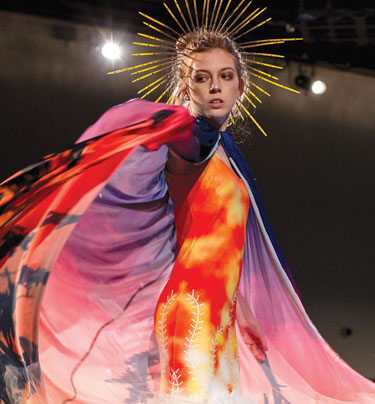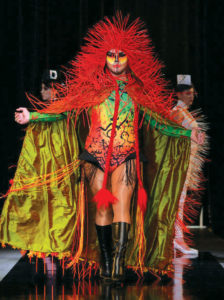Maine’s Native American fashion designers
seize the international spotlight.
By Sofia Voltin
 The Wabanaki designers Decontie & Brown are taking center stage across the fashion universe. The married duo Jason Brown and Donna Decontie-Brown kicked off the spring with their Wabanaki-inspired fashion show at Portland Masonic’s “Mr. Longfellow’s Cocktail party” fundraiser. In August, the Bangor residents brought their designs to the Haute Couture Fashion Show event at the renowned Santa Fe Indian Market and took both the first and second place ribbons in contemporary jewelry, too. One of their runway designs, “Dawnland,” was featured in Vogue.
The Wabanaki designers Decontie & Brown are taking center stage across the fashion universe. The married duo Jason Brown and Donna Decontie-Brown kicked off the spring with their Wabanaki-inspired fashion show at Portland Masonic’s “Mr. Longfellow’s Cocktail party” fundraiser. In August, the Bangor residents brought their designs to the Haute Couture Fashion Show event at the renowned Santa Fe Indian Market and took both the first and second place ribbons in contemporary jewelry, too. One of their runway designs, “Dawnland,” was featured in Vogue.
“Normally, you only find Native American art next to the dinosaur exhibit,” Jason Brown says. “We’re bringing antiquity and contemporary art together. We expose people to what’s ancient about who we are through our creativity, and we do it in a way that seems futuristic—especially with the creations we send down the runway. It subliminally says, ‘We’re not going anywhere. We’re going to remember who we are. It’s ok to evolve, but we’ll still hold on to our culture and heritage.’”
While including traditional Wabanaki elements into their cutting-edge concepts, Decontie & Brown also pull from the Maine landscape to fuel their creativity. “We are surrounded by endless inspiration in nature,” says Donna Decontie-Brown. “From the great horned owl, the brown ash tree, to our traditional food (the fiddlehead), all have led to designs both in jewelry and fashion.”
“Forsythia is an outfit that was completely inspired by Maine,” says Brown. “Every Mainer can relate to a tough winter. We look forward to the forsythia flowers because it’s one of the first things to bloom each spring. You’ve got to respect a plant that’s so excited for spring—like the rest of us—it can’t even wait for its leaves to grow. The flower shoots out first.”
Decontie-Brown’s heart lies even closer to another design from the runway. “Armored Beauty is my current favorite piece,” she says. “It’s a visual representation of empowerment. We strategically and intentionally adorn the hand-painted gown with spikes in areas of the body where women are typically touched, often without their permission. This gown sends the message, “You cannot put your hands on me without my consent. I’m deserving of respect, and you will treat me accordingly!”

“It doesn’t get more ancient than Klouscap. When the earth was new & wild, everything was out of control, so the Creator put Klouscap on the earth to make the land safe for humans. Klouscap dressed as an autumn porcupine warrior was completely an original creation—not from the legends. I borrowed the legend and made it into
something new.”
From Motion to Emotion
The market’s celebration of antiquity with contemporary art stretches beyond the runway. Jeremy Frey won best in basketry both this year and last. “I use all traditional ideas, techniques and weaves, but I put things together in a more contemporary way,” he says. “I carry my culture in my art. I’m sad to say I don’t know our language, but I know the language of weaving.” I honor our culture through my art.” Frey specializes in creating ash baskets, central to the Wabanaki method. “Ash basketry was originally used to store food and transport things around—‘ancient Tupperware’ as I call it. As we got colonized and a monetary system came into play, an elaborate, artistic version of the ash baskets developed around the turn of the century. My baskets are currently on display at the Maine Historical Society, the Portland Museum of Art, and Colby Museum of Art.”
WíwƏnikan…the beauty we carry is a contemporary art exhibit at Colby through January 12, 2020. Two jewelry pieces by Jason Brown lend a sense of mythic astonishment to the exhibit. The Basket Inlay Cuff is made from .935 argentium silver, with turquoise, lapis, dalmatian, Ethiopian opal, Siberian jet, Maine jasper, granite and rhyolite, shed deer antler, and woven brown ash. “This is the first-ever inlaid miniature brown ash basket and pays homage to the master jewelers of the southwest with a Wabanaki aesthetic,” says Brown. “The creation cuff is one of my originals created in copper and brown ash. It depicts the Wabanaki creation story— Klouscap shot his arrow into the brown ash tree and the Wabanaki came out of the tree.”
“We’re sharing our culture, the beauty of where we’re from, and celebrating our creativity,” says Brown. “A lot of people are afraid of cultural appropriation. When you wear work by a Native American designer, we’ve already vetted it for you. We want people to know and realize that what we do is for everybody. If you like what we do and it makes you feel fabulous, then it’s for you—regardless of your race or body type. We are for everybody.”
“Fixed Stars Govern a Life”
The Santa Fe Indian Market—a celebration that highlights both traditional and contemporary Native American Art—makes use of the word “Indian” when referring to Native Americans. To some it might seem outdated. It puts others’ teeth on edge.
“The show is a hundred years old,” says Jeremy Frey. “It would be strange to change the name now. I don’t think [Indian] is derogatory—I think its origins are, but even then it was based more out of ignorance.”
“Since I’m a member of two tribes, I refer to myself as Penobscot and Anishinabe,” Donna Decontie-Brown says. “I refer to others according to the tribe they’re from rather than using a blanket term, unless one’s tribe is unknown or I’m referring to people from numerous tribes. I prefer to use Native American or Indigenous rather than Indian. I just feel that Native American and Indigenous are more reflective of who we are.”
“For me, it’s not the word [Indian], it’s the intent behind it,” Jason Brown says. “I know who I am regardless of how people describe me or how people refer to me. I love the term ‘Indigenous.’ Words are powerful. Choose them wisely.”
(The Smithsonian Institute engages the controversy directly with its “National Museum of the American Indian.” What are your thoughts and feelings? Email staff@portlandmonthly.com. Also see Sylvia Plath’s poem “Words.”)





0 Comments